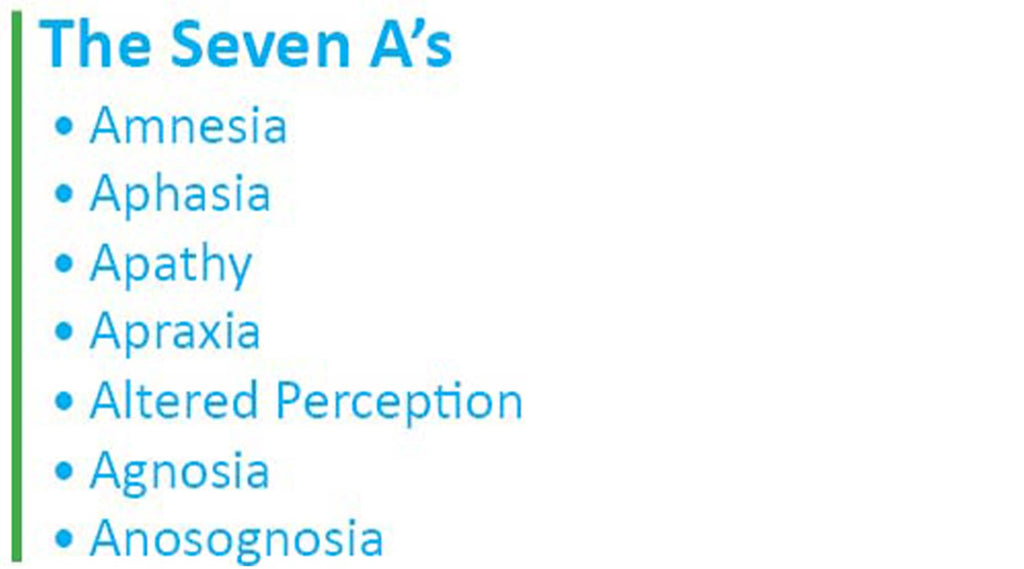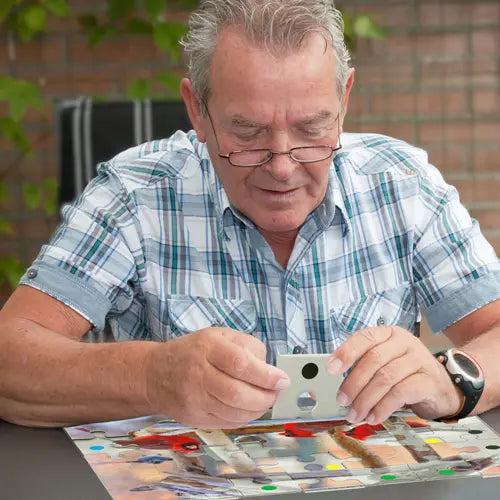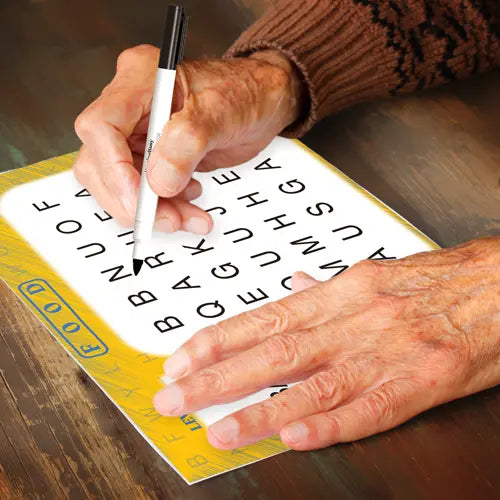
Dementia is an all-encompassing term that covers many different diseases. What they all have in common is that all types of de mentia are caused by damage to the brain. The difference between the dementias is the part of the brain that has been damaged. Understanding the exact form of dementia isn't as important as understanding how it affects the person and what we can do to help.
One way of understanding this is to look at the Seven A's of Dementia. Each of the "A's" represents damage to a different part of the brain. While we talk about them separately, a person with dementia may experience any number of the Seven A's depending on the form of the disease.
Learning about the Seven A's helps us to understand the way a person with dementia sees the world, which gives us insight that can help us better interact with the person, and develop supportive care strategies.
AMNESIA
Amnesia is the loss of memory. It is a significant loss because almost everything that we do depends on memory to some extent. Short term memory is generally the first affected, and as the disease progresses, long term memories become harder to retrieve.
Behaviors
- Repeating things
- Becoming overwhelmed by too much new information
- Accusing others of stealing items, not visiting, withholding information, etc.
- Not being oriented to time - living in the past
- Forgetting names and recent events
Care Strategies
- Provide cues and reminders such as a diary or schedule, sign in book for visitors and photos of family and friends
- When offering information multiple times, don't point out that it was already provided and forgotten
- Treat repetitions as if it was the first time
- Do the same things at the same time in the same way to create a routine
APHASIA - NON VERBAL DEMENTIA
Aphasia is the loss of the ability to use language, including speaking, understanding, reading and writing. Early in the disease the person may retain the ability to speak, but their ability to understand will be affected. Because they have difficulty interpreting what they hear, aphasia can mask their inherent competence. Many people with aphasia know what is going on and are capable of making decisions and have a desire to socialize but they cannot communicate their feelings and thoughts, nor understand what others are saying. This can result in misunderstandings and confusion leading to the person withdrawing from social interactions.
Behaviors
- Difficulty finding words
- Using an inappropriate or non-existant word
- Reverting to first language, even if not used for years
- Social isolation and withdrawal
- Needing extra time to process and/or not responding correctly
Memory Care Strategies
- Speak slowly and clearly
- Use visual cues and gestures
- Be aware of your body language and facial expressions
- Give the person extra time to respond
- Be aware of pain or discomfort that the person may be feeling but cannot express
APATHY
A person with apathy lacks motivation or initiative. They have difficulty initiating an activity and often agree to do something but then don't participate unless encouraged.
Behaviors
- Appearing not to care about anything
- May spend most of the day sitting in silence with their chin on their chest, but will respond when called by name
- Doesn't initiate any activity
Care Strategies
- Help the person initiate an activity such as eating by using verbal and non-verbal cues
- Visit with the person on a regular basis
- Gently encourage them to participate in an activity that they previously enjoyed
APRAXIA
Someone with apraxia has difficulty carrying out purposeful movement. The person cannot complete a motor task such as buttoning their shirt even though they want to do it and are otherwise able to do it. They have difficulty determining the order in which to do things to accomplish the task ("sequencing"). To help them, tasks should be broken down into small, individual steps.
Behaviors
- Difficulty sequencing the steps required for tasks
- Inability to do ADL's (dressing, grooming and eating) because of the inability to sequence the steps involved
- Difficulty with push-button items such as remote controls, telephones and microwaves
- Saying "no" to a question about participation not because they can't do it but because they don't remember how to do it
Care Strategies
- Give short, simple instructions for each step required
- Demonstrate the action required
- Set out clothes in the correct order to help them dress independently
- Minimize distractions
ALTERED PERCEPTION
A person with altered perception misinterprets the information from their senses, which can lead to paranoia and delusions. Depth perception is affected making it difficult for the person to judge how high, long, wide, deep, near or far things are. Bathwater may seem to be too deep, it may be difficult for the person to judge when the chair is close enough to sit on.
Behaviors
- Poor depth perception - may cause a resistance to bathing because water is perceived to be too deep
- Jumping over dark spots on floor (dark tiles, thresholds) because they appear to be crevices or holes, avoiding dark floors because they appear to be water or a ditch
- Misinterpreting poles, clothing on a chair as people
- Hallucinations, delusions
- Suspicions and paranoia
Care Strategies
- Try to understand how the world looks to them and act accordingly
- Adjust the environment to minimize misinterpretation by use of appropriate lighting and colors
- Avoid arguing about reality and instead work around the problem
AGNOSIA
Someone with agnosia can no longer recognize things using their senses of sight, sound, touch, taste and smell. They have trouble recognizing familiar people and common objects, using them inappropriately which can lead to safety issues. The person may not recognize that the wash water is too hot and burn themselves, or they may eat something because they think that it is food, even though it is not.
Behaviors
- Loss of recognition of family and friends, starting with the latest additions such as grandchildren
- Thinking that they are much younger than in actuality, causing confusion with spouses and children
- Thinking that a family member or care provider is an imposter, which can result in the perception that a stranger is watching them undress, bathe, etc.
- Eating unusual things
- Misusing objects, such as using a spoon to cut their food, or a knife for eating - can lead to safety issues
Care Strategies
- Demonstrate the proper use of an object prior to giving it to the person or administering care with it
- Introduce yourself and provide reassurance that other people in the room are family or care providers
- Simplify the materials that you offer to the person, making it easier for them to be used appropriately
ANOSOGNOSIA
Anosognosia is the lack of awareness or insight. Someone with this condition likely does not realize that they have cognitive problems and think that their abilities are unimpaired even though their symptoms are obvious to others. Because of this, you cannot reason with them and they can become angry with offers of assistance.
Behaviors
- Refuses assistance or aids
- Difficulty appreciating their need for help - "they don't know, they don't know"
- Overestimation of abilities, poor judgement
- Unaware that they are in a hospital or care facility
- Unaware of consequences of their behavior on others
- May become angry with caregivers
Care Strategies
- Understand that the behaviors are not willful, it is the disease
- Smile, use positive words and friendly, relaxed tone
- "Normalize" assistance - "I do this for everyone", or suggest that it is temporary - "Just this once"
- Avoid arguing - a negative interaction can have lasting effects




